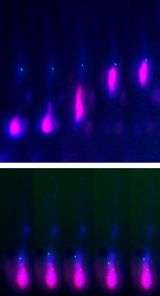Scientists Peer Into Stem Cells in Live Brain

Columbia University Medical Center scientists report they have observed the detailed sub-cellular behavior of neuronal precursor cells in living rat brain tissue.
These observations, published July 8 in the journal Nature Neuroscience and authored by University researchers Jin-Wu Tsai, Helen Bremner, and Richard Vallee, provide extensive insight into the mechanisms powering neuronal cell migration. Medical Center officials call it the most highly detailed information to date into how this process fails in a number of severe developmental brain disorders.
According to Dr. Vallee, the paper's senior author and professor of Cell Biology and Pathobiology Graduate Program at CUMC, this study has implications for a number of disorders. In addition to their involvement in brain development, neuronal precursor cells have the potential for repopulating damaged brain regions.
Dr. Vallee says that neuronal precursor cells may also provide insight into the behavior of brain cancer cells, which seem to recapitulate the ability of the precursors to multiply and migrate. Thus, this new work could ultimately provide novel avenues for cancer chemotherapy.
The neuronal precursor cells, located at the surface of the ventricles in the developing brain, undergo numerous successive cycles of division to populate the forming cerebral cortex, the part of the brain responsible for cognitive function. As new cells are produced they migrate outward over considerable distances to find their proper location in the developing brain. Defects in the division of these cells can lead to microencephaly, or “small brain,” and defects in migration can lead to lissencephaly, or “smooth brain.” Although diseases involving particular brain developmental genes are relatively rare, together this class of disorder is more common.
To observe these brain processes directly, Tsai, a Ph.D. student in Columbia's prestigious Integrated Program in Cellular, Molecular and Biophysical Studies, introduced DNA probes into embryonic rat brain in utero, an approach increasingly employed in research on brain development. Using RNA silencing of the LIS1 gene, known to be responsible for the most common form of lissencephaly, the group previously reported a complete block in the division and migration of neuronal precursor cells.
Source: Columbia University



















